Hi All,
I am posting today a sample Comsol Multiphyiscs application Model. I am Presenting a model in Femlab of induction stirred ladle furnace. The geometry of the model is shown in figure 1. 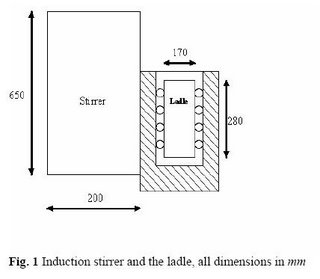

There is a induction coil which produces magnetic field. It is placed near a cylindrical ladle containing a conducting fluid or motlen steal.
The Basic governing equation are the well known Maxwells equation which gives the magnetic field in terms of a Magentic Diffusion equation given as:
dB/dt = 1/(sigma*mu)*(del^2(B)) --------------- (1)
The Solution of the above Magnetic diffusion equation will give the Magnetic field Bx, By and Bz as a function of time. These Magnetic field can then be used to find the Lorenz Force which will induce motion of the Melt/molten liquid inside the ladle. Given as :
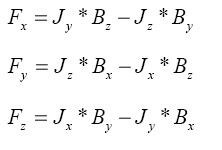 These force field are fed into the NS or K-e model as source term for obtaining the solution of the velocity field in the melt. The Modelling is then done as follows:
These force field are fed into the NS or K-e model as source term for obtaining the solution of the velocity field in the melt. The Modelling is then done as follows:I tried to model it in 2 D and 3 D. Although 3 D model is more accurate. While modelling in 2D I assumed that the magnetic filedis in Bx and By direction only. The interaction of magnetic field and induced current will produce Lorenz force which will rotate the liquid metal in the cylindrical ladle placed near the induction coil. In 3d the inductor is modelled as current carrying coil. The coil geometry is created in MATLAB and then imported into COMSOL. To compute the velocity field in the model, I have coupled the two models using multiphysics option. I have coupled 3D quasi Static and 3D incompressible Navierstokes while modelling in 3D. In 2D modelling I have coupled k-e model and perpendicular current in electomagnetics. Now to solve the problem the the solve manager is used separately. First you solve the Electromagnetics (QAV) problem only, calculating the forces. Then you only solve the Navier Stokes (NS) using these forces. The forces will be constant during this solution process. You do this with the Solver manager under the tab Solve for. Here you select the QAV mode when you solve the quasi statics and NS mode for Navier stokes. After the QAVsolution you must select Current solution as initial value. Your Navierstokes problem also need some help in defining the pressure, otherwise it will be undefined. Specify a point constraint in one point under pointsettings to a certain pressure. Also believe that you need denser mesh inthe container where you solve the NS problem.
On running the solver now I do get the solution of the magnetic field and also the induced currents and the melt velocity field. The model here is described in very brief, if any one required more information about current density setting and how to make a coil in MATLAB and how to import in into COMSOL just write a querry on the blog.
The Figure below shows the model in COMSOL in 2 and 3D.
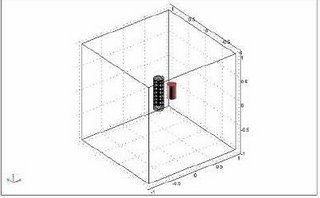
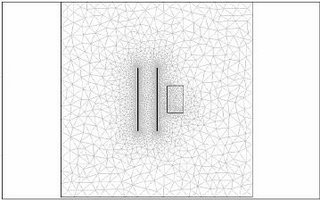
The Results are shown here in 2D and 3D
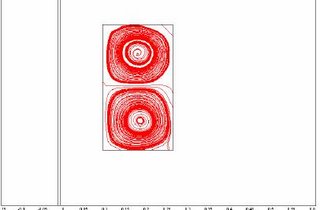
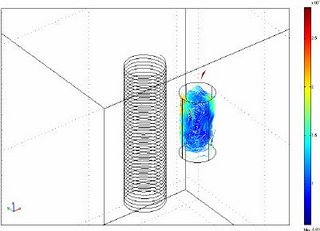
21 comments:
Hi,
I would like to know how did you manage to draw the inductor. In the 3D model looks like you have drawn all the wires, however in the 2D model looks like a foil conductor. Did you have any memory problems?
Hi, Sorry for delayed response...Yeah in 3D the inductor is modeled as a oil and in 2D as thin slices. I had memory issues in begining but then I contacted the comsol guy and they suggested me to use iterative solver and also they suggsted me to use the solver independetly. As the model has two modules so its possible to select in solver setting to solve for and store the solution and then solve for the next module using the previous solution. Which helped and I didnt have any memory issues after that. I hope that helps.
Thank you very much. Which one is the best iterative solver for quasi-static problems? I have tried to use them but I haven't got satisfactory results. Perhaps is my computer problem, I have read that is recommendable to use 64 computer to solve electromagnetic problems, and especially 3D problems.
Thanks. Irma.
Hi,
I used GMRES. I had 1gb ram also on that machine. That helped. You are right 64 bit is recommended. But more ram could also be helpful.
Hi,
i have some question about your model, i need to modelize a coil in 2D, can you give me some tips? In 3D how i can draw a coil in MATLAB and then import that in Comsol? I tried with helix2 and helix3 in comsol script but, in my opinion, there are too heavy! Can you send me your model at higor (at) gmx (dot) it.
Thank you
hi all
I am trying to model incident and reflected power at the fiber-water interface. I have tried to use hybrid mode analysis and it doesnt seem to work.is there a way I can differentiate between incident and reflected radiation.
Thanks
How would you compare COMSOL to other FEM packages (ABAQUS/SIMULIA, Ansys, etc)? It seems like COMSOL is now the big mover and shaker in FEM world, especially in academia.
Citlalli
hello I want know how can i modelling a coil with Comsol, well more specifically i have problems with the boundary conditions and subdomain settings. If you have some information about this topic that you could send to me, i thank you very much. My e-mail is yoda34@hotmail.com
thank you very much
Hi,
Can you please tell me how to solve two simultaneous(interlinked)diferential equations with the femlab??
Can Someone throw light on how to model a tensile loaded specimen taking account thermoelastic & thermoplastic effects
Hi All,
I am trying to solve a problem where the solutions are expected to be zero for a very long time.
I have refined the mesh with the maximum element size of 0.002 and am using the GMRES method with preconditioning quality of 0.01.
However, inspite of it, the system is unable to process the solution and gives an error for residual computation citing singular matrix as the problem.
Can anyone please suggest some ways to solve the problem?
what sort of problem is it...singular matix error occurs if something is wrong in your boundary conditions...you have to specify one value at any one point in the boundary...
Hello!
I also would like to know which is the best option to draw a coil with comsol.or some option to simulate a magnetic field source with comsol.
please help me.
my email is:
natisof18@hotmail.com
Hi everyone,
I would like to know how to implemented a weak form into COMSOL.
Somebody to help me?
Hi,
Will you please tel me, how did you manage to model the coil in MATLAB ? I am now modelling a 3D Electromagnet in which I need to model the coil as well. Please send your model or some tips how to model it to the address,
kiran.sahu@vtt.fi
COMSOL Multiphysics (formerly FEMLAB) is a finite element analysis, solver and Simulation software package for various physics and engineering applications, especially coupled phenomena, or multiphysics. COMSOL Multiphysics also offers an extensive interface to MATLAB and its toolboxes for a large variety of programming, preprocessing and postprocessing possibilities. The packages are cross-platform (Windows, Mac, Linux, Unix.) In addition to conventional physics-based user-interfaces, COMSOL Multiphysics also allows for entering coupled systems of partial differential equations (PDEs). The PDEs can be entered directly or using the so called weak form (see finite element method for a description of weak formulation). I am a college sophomore with a dual major in Physics and Mathematics @ University of California, Santa Barbara. By the way, i came across these excellent physics flash cards. Its also a great initiative by the FunnelBrain team. Amazing!!
I am interested in coil modelling as well. tenorsax at gmail if you are interested in discussing this topic. thanks
Hi,
Can you please tell me how did you model your coil in MATLAB and then import it to COMSOL? My email address is: alireza_hekmati@sfu.ca
Thank you in advance.
Can you please also send me an email and tell me how you modelled the coil in Matlab and imported it in Comsol ? I really need to create one, but don't know how to use Matlab, and can't find tuts.
my email: wane.aion(at)gmail.com
Thanks
Hey everybody:
Various people have already asked. I was wondering if someone could send me the 3D coil model for Matlab. I'm also trying to model a 3D electromagnet. My email is guiroserge321(at)hotmail.com
Thanks
-Sergio
Hi, I am trying to model maxwell's equations in any given condition using the PDE modes (not any modules). Could someone please direct me to the right path?
My email is rkn_nepal@hotmail.com
Post a Comment